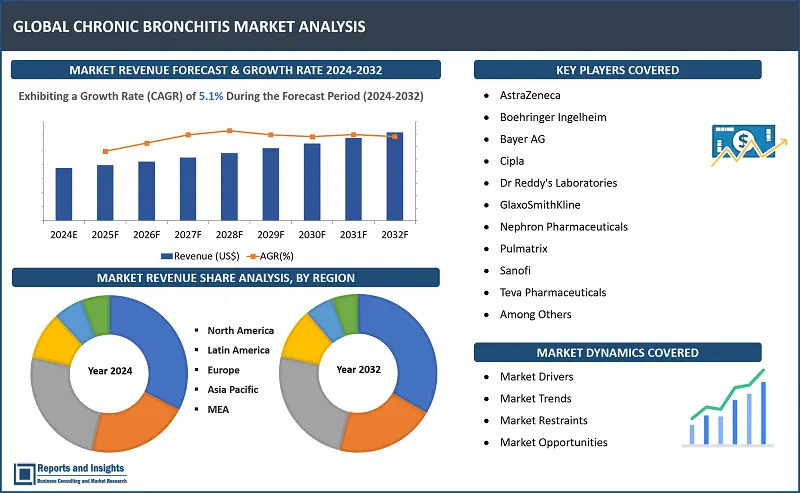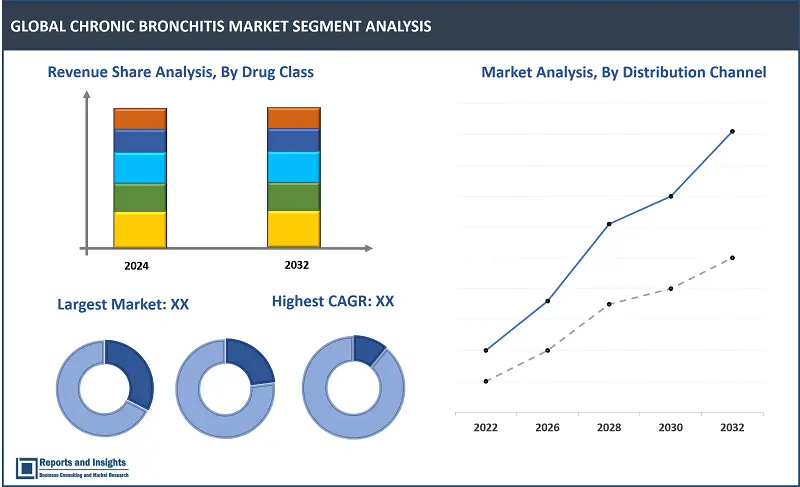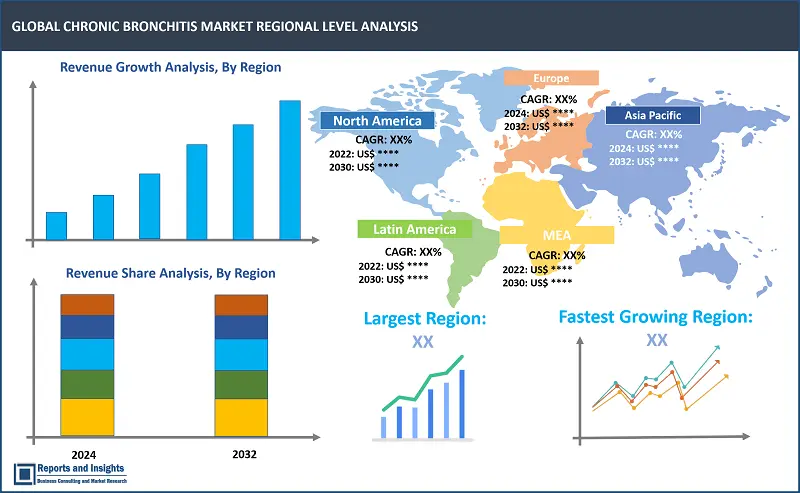Market Overview:
"As per Reports and Insights analysis, the global chronic bronchitis market was valued at US$ 5.6 Billion in 2023, and is expected to register a CAGR of 5.1% over the forecast period and reach US$ 8.3 Bn in 2032."
|
Report Attributes |
Details |
|
Base Year |
2023 |
|
Forecast Years |
2024-2032 |
|
Historical Years |
2021-2023 |
|
Market Growth Rate (2024-2032) |
5.1% |
Chronic bronchitis, a perpetual inflammation of the bronchial tubes, presents a critical global health challenge. This condition, marked by a prolific cough lasting not less than three months in two subsequent years, often leads to breathing complexities and lowered quality of life for millions globally. The global market for chronic bronchitis treatment and management solutions is experiencing strong growth, propelled by rising awareness, advancements in medical technologies, and the rising prevalence of respiratory diseases. Pharmaceutical interventions, comprising corticosteroids, bronchodilators, and mucolytics, form a significant segment of this market. in addition, advanced therapies such as pulmonary rehabilitation programs and targeted biologic treatments are gaining momentum. With an increasing geriatric population and elevating pollution levels, the demand for effective chronic bronchitis management is estimated to rise, fuelling further investment and innovation in this dynamic market panorama.
In the sphere of chronic bronchitis, technological breakthroughs and novel trends are redefining treatment paradigms. Progressive inhalation devices, such as digital spirometers and smart nebulizers, provide precise drug delivery and real-time monitoring, improving patient adherence and outcomes. Alongside, the integration of telemedicine supports remote patient monitoring and personalized care, specifically essential amid the COVID-19 pandemic. Biomarker-based diagnostics and gene therapies offer commitment for targeted interventions, while persistent research into anti-inflammatory agents and immune-modulating drugs indicates a soaring emphasis on holistic disease management. These trends underline a dynamic outlook in which technology holds a crucial role in optimizing chronic bronchitis care worldwide.
In recent years, several leading companies in the global chronic bronchitis market have made substantial strides in advancing treatment alternatives and presenting cutting-edge technologies in the market. For instance, GlaxoSmithKline have been in the lead of developing advanced medications, comprising inhaled corticosteroids, long-acting bronchodilators, and combination therapies, focused on enhancing symptom management and decelerating disease progression. Moreover, companies like Teva Pharmaceuticals have aimed their focus on developing state-of-the-art inhalation devices, combining features such as digital connectivity and smart monitoring capabilities to improve patient adherence and therapeutic results. These industry leaders' commitment to research and development highlights collaborative efforts to revolutionize chronic bronchitis treatment and enhance the lives of millions affected by this exhaustive respiratory condition.

Chronic Bronchitis Market Trends and Drivers:
One prominent factor that is primarily driving the chronic bronchitis market growth is the increasing prevalence of chronic obstructive pulmonary disease (COPD), of which chronic bronchitis is a significant component. According to the World Health Organization, Chronic obstructive pulmonary disease (COPD) is the third leading cause of death worldwide, causing 3.23 million deaths in 2019. With geriatric populations and surging rates of smoking and air pollution worldwide, the burden of COPD continues to escalate, accelerating the demand for effective treatments for chronic bronchitis.
Additionally, another driver defining the market is the soaring demand for combination therapy. As the understanding of the disease deepens, it becomes evident that a multifarious approach is time and again essential for optimal management. Combination therapies, which generally combine corticosteroids, bronchodilators, and other agents, offer symbiotic benefits in symptom control and disease modification. Thus, pharmaceutical companies are investing in research and development to devise novel combination regimens that target different aspects of the disease pathophysiology, improving treatment outcomes and patient adherence.
Advanced clinical research and innovative strategies are also holding a crucial role in fuelling progress in the chronic bronchitis market. Ranging from biomarker identification to gene editing techniques, the panorama of respiratory medicine is experiencing a wave of pioneering research endeavours. These initiatives are leading the way for precision medicine approaches customized to individual patient profiles, as well as the development of targeted biologic therapies that address specific molecular pathways implicated in chronic bronchitis. Furthermore, innovative strategies such as digital health solutions, patient-centric drug delivery systems, and telemedicine platforms are transforming how care is delivered, enhancing accessibility and improving patient engagement.
Chronic Bronchitis Market Restraining Factors:
One major challenge is the lack of awareness among both healthcare professionals and the general population regarding the early symptoms, risk factors, and available treatment alternatives for chronic bronchitis. This limited awareness often leads to underdiagnosis and delayed initiation of appropriate therapies, aggravating the burden of the disease and confining market expansion.
In addition, the high costs associated with chronic bronchitis management pose a significant restraint on market growth. From diagnostic tests and prescription medications to hospitalizations and long-term care, the financial strain of managing chronic bronchitis can be crucial for patients and healthcare systems alike. Limited access to affordable healthcare services and medications further worsens this issue, specifically in low- and middle-income countries where resources are strained.
Moreover, reimbursement challenges and regulatory hurdles in certain regions are likely to hamper the adoption of novel therapies and advanced treatment modalities, impeding market penetration and restraining the commercialization of promising developments. Addressing these detaining factors will require conjunctive efforts from policymakers, industry stakeholders, healthcare providers, and advocacy organizations to raise awareness, enhance access to care, and develop sustainable solutions for chronic bronchitis management on a global scale.
Chronic Bronchitis Market Opportunities:
The increasing prevalence of smoking, particularly in emerging economies, represents a substantial opportunity for market expansion. Since smoking remains the primary cause of chronic bronchitis, efforts to inhibit tobacco use and facilitate smoking cessation initiatives could lead to greater demand for treatments and preventive measures, fuelling market growth.
Moreover, the surging number of clinical trials emphasized on chronic bronchitis and associated respiratory conditions presents a fertile ground for innovation and the development of novel therapeutic interventions. With pharmaceutical firms and research institutions investing in clinical research to explore new drug candidates, biomarkers, and treatment modalities, there is a growing pipeline of promising therapies that hold the potential to revolutionize the management of chronic bronchitis.
Over and above, breakthroughs in diagnostic technologies, such as imaging modalities and biomarker identification techniques, offer opportunities for early detection and personalized treatment approaches, improving patient outcomes and boosting market expansion. Concerted efforts among stakeholders across the healthcare continuum to leverage these opportunities could lead to remarkable breakthroughs in chronic bronchitis management, ultimately enhancing the lives of millions affected by this enfeebling respiratory condition.
Chronic Bronchitis Market Segmentation:

By Treatment Type
- Pharmacological
- Nonpharmacological
- Others
The pharmacological segment is estimated to account for largest revenue share over the forecast period. The pharmacological segment holds a larger share due to the widespread use of medications such as bronchodilators, corticosteroids, and antibiotics for symptom management and disease modification, indicating their established efficacy and broad applicability.
By Drug Class
- Bronchodilators
- Glucocorticoids
- Antibiotic
- Phosphodiesterase-4 Inhibitors
- Others
Bronchodilators holds the largest market share in the chronic bronchitis treatment market over the forecast period for the management of the severity. They are very effective to provide rapid relief from symptoms such as shortness of breath, wheezing, and coughing, among others. Bronchodilators have the ability to quickly open up airways and making them a preferred choice for managing the severity of breathlessness. Even, the bronchodilators are also in combination with different classes for effective management.
By Distribution Channel
- Hospital Pharmacies
- Retail Pharmacies
- Online Pharmacies
The hospital pharmacies segment accounted to hold largest revenue share in the global chronic bronchitis market in the year 2023 and is expected to maintain its dominance throughout the forecast period, owing to the preference for accessing specialized care and prescription medications within healthcare facilities, ensuring immediate availability of treatments and comprehensive management under medical supervision.
By End User
- Hospital
- Rehabilitation Centers
- Specialty Clinics
- Others
The hospital segment dominates the global chronic bronchitis market owing to its role as a primary care setting for acute exacerbations and severe cases. Hospitals provide comprehensive diagnostic facilities, specialized medical expertise, and access to advanced treatment modalities for managing chronic bronchitis effectively.
By Region

North America
- United States
- Canada
Europe
- Germany
- United Kingdom
- France
- Italy
- Spain
- Russia
- Poland
- Benelux
- Nordic
- Rest of Europe
Asia Pacific
- China
- Japan
- India
- South Korea
- ASEAN
- Australia & New Zealand
- Rest of Asia Pacific
Latin America
- Brazil
- Mexico
- Argentina
Middle East & Africa
- Saudi Arabia
- South Africa
- United Arab Emirates
- Israel
- Rest of MEA
The global Chronic Bronchitis market is divided into five key regions: North America, Europe, Asia Pacific, Latin America, and the Middle East and Africa. North America has been a leading regional market for Chronic Bronchitis, with the United States at the forefront due to growing infection in geriatric population, and increasing population with smoking habits. Asia-Pacific is expected to account for the largest market share over coming years for the chronic bronchitis market due to increased prevalence of COPD, asthma and other lungs diseases and increasing initiatives taken by the government and pharmaceutical organizations to spread awareness. The increasing prevalence of COPD, rising awareness about respiratory health, advancements in treatment options, and a growing elderly population susceptible to chronic respiratory conditions are common factors driving growth of these regional markets.
Leading Chronic Bronchitis Solution Providers & Competitive Landscape:
Leading pharmaceutical companies such as GlaxoSmithKline are focusing on research and development initiatives to innovate new treatment options and expand their product portfolios. Meanwhile, medical device manufacturers like Teva Pharmaceuticals are investing in advanced inhalation technologies to enhance drug delivery systems. Additionally, strategic collaborations, mergers, and acquisitions are common tactics to strengthen market presence and access new markets. With the increasing prevalence of chronic bronchitis, competition is intensifying, prompting companies to continually innovate and adapt to meet evolving patient needs and market demands.
These companies include:
- AstraZeneca
- Boehringer Ingelheim
- Bayer AG
- Cipla
- Dr Reddy's Laboratories
- GlaxoSmithKline
- Nephron Pharmaceuticals
- Pulmatrix
- Sanofi
- Teva Pharmaceuticals
- Among Others
Recent Development:
- July 2023, Hormosan Pharma GmbH, Lupin’s wholly-owned subsidiary in Germany, announced the launch of Luforbec 100/6 (beclometasone 100µg / for moterol 6µg), a fixed combination in a pressurized metered dose inhaler (pMDI) for the treatment of adult asthma and chronic obstructive pulmonary disease (COPD) including chronic bronchitis and emphysema in Germany. Luforbec 100µg/6µg pMDI is the use of an inhaled corticosteroid and long-acting beta2-agonist (ICS/LABA) is suitable
- March 2023, UC Davis Health is turning to a digital health solution from Propeller Health to monitor treatment for high-risk patients with chronic obstructive pulmonary disease (COPD) including bronchitis and emphysema. UC Davis Health will provide the Propeller program including sensors, mobile app, a web portal, and personalized support to eligible patients, with eventual expansion to patients in other UC locations and UC affiliates. The sensors attach to a patient’s inhaler to capture signals that record events, such as medication usage or respiration
- November 2022, C4X Discovery Holdings and AstraZeneca entered into a licensing deal to develop an oral treatment for chronic bronchitis, emphysema, and other inflammatory and respiratory illnesses, the companies announced. The partners will focus on developing C4XD’s NRF2 Activator program with an initial focus on COPD. The agreement could reach $402 million
Chronic Bronchitis Market Research Scope
|
Report Metric |
Report Details |
|
Market size available for the years |
2021-2023 |
|
Base Year |
2023 |
|
Forecast Period |
2024-2032 |
|
Compound Annual Growth Rate (CAGR) |
5.1% |
|
Segment covered |
Treatment Method, Drug Class, Distribution Channel, End User |
|
Regions Covered |
North America: The U.S. & Canada Latin America: Brazil, Mexico, Argentina, & Rest of Latin America Asia Pacific: China, India, Japan, Australia & New Zealand, ASEAN, & Rest of Asia Pacific Europe: Germany, The U.K., France, Spain, Italy, Russia, Poland, BENELUX, NORDIC, & Rest of Europe The Middle East & Africa: Saudi Arabia, United Arab Emirates, South Africa, Egypt, Israel, and Rest of MEA |
|
Fastest Growing Country in Europe |
UK |
|
Largest Market |
North America |
|
Key Players |
AstraZeneca, Boehringer Ingelheim, Bayer AG, Cipla, Dr Reddy's Laboratories, GlaxoSmithKline, Nephron Pharmaceuticals, Pulmatrix, Sanofi, Teva Pharmaceuticals |
Frequently Asked Question
What is the market size of the chronic bronchitis market in 2023?
The Chronic Bronchitis market size reached US$ 5.6 Billion in 2023.
At what CAGR will the chronic bronchitis market expand?
The market is expected to register a 5.1% CAGR through 2024-2032.
Which is the fastest growing country in Europe?
The U.K. is the fastest growing country in Europe.
What are some key factors driving revenue growth of the chronic bronchitis market?
Some key factors driving revenue growth are increasing prevalence of COPD, rising awareness about respiratory health, advancements in treatment options, among others.
What are some major restraints hampering the growth of chronic bronchitis market?
Some key restraints include lack of awareness among both healthcare professionals and the general population regarding the early symptoms, risk factors, and available treatment alternatives for chronic bronchitis.
How is the competitive landscape in the Chronic Bronchitis market?
The competitive landscape in the chronic bronchitis market is dynamic with solution and service providers investing in R&D, strategic partnerships with technology providers, and development of comprehensive service offerings, including consulting and training.
How is the Chronic Bronchitis market segmented?
The market report is segmented based on treatment type, drug class, distribution channel, end user, and region.
Which top companies are included in the global Chronic Bronchitis market report?
Top companies included in the report are AstraZeneca, Boehringer Ingelheim, Bayer AG, Cipla, Dr Reddy's Laboratories, GlaxoSmithKline, Nephron Pharmaceuticals, Pulmatrix, Sanofi, Teva Pharmaceuticals.

